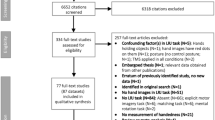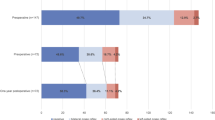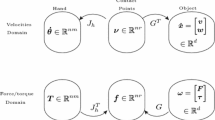Abstract
In this study, we investigated anticipatory motor planning and the development of cognitive representation of grasp postures in children aged 7, 8, and 9 years. Overall, 9-year-old children were more likely to plan their movements to end in comfortable postures, and have distinct representational structures of certain grasp postures, compared to the 7- and 8-year old children. Additionally, the sensitivity toward comfortable end-states (end-state comfort) was related to the mental representation of certain grasp postures. Children with grasp comfort related and functionally well-structured representations were more likely to have satisfied end-state comfort in both the simple and the advanced planning condition. In contrast, end-state comfort satisfaction for the advanced planning condition was much lower for children whose cognitive representations were not structured by grasp comfort. The results of the present study support the notion that cognitive action representation plays an important role in the planning and control of grasp postures.



Similar content being viewed by others
Notes
Based on previous research demonstrating that grasping behaviour in the bar transport task is relatively consistent between trials (e.g., Thibaut and Toussaint, 2010; Weigelt and Schack, 2010) and that behaviour should be similar irrespective of initial bar orientation (black end oriented to the right, black end oriented to the left), we used two trials per condition to test for end-state comfort sensitivity.
See a detailed description of the SDA-M in the electronic supplementary material.
Although the majority of children clustered the pictures with ambiguous grasps (pictures 2, 4, 6) with the comfortable grasps (pictures 1, 3, 5), they were not used in the classification of group affiliation.
We thank an anonymous reviewer for pointing out this possibility.
References
Adalbjornsson, C. F., Fischman, M. G., & Rudisill, M. E. (2008). The end-state comfort effect in young children. Research Quarterly for Exercise and Sport, 79, 36–41.
Blaesing, B., Schack, T., & Brugger, P. (2009). The functional architecture of the human body: Assessing body representation by sorting body parts and activities. Experimental Brain Research, 203, 119–129.
Braun, S. M., Beurskens, A. J. H. M., Schack, T., Marcellis, R. G., Oti, K. C., Schols, J. M., et al. (2007). Is it possible to use the SDA-M to investigate representations of motor actions in stroke patients? Clinical Rehabilitation, 21, 822–832.
Claxton, L. J., Keen, R., & McCarty, M. E. (2003). Evidence of motor planning in infant reaching behavior. Psychological Science, 14, 354–356.
Grafton, S. T., Fadiga, L., Arbib, M. A., & Rizzolatti, G. (1997). Premotor cortex activation during observation and naming of familiar tools. Neuroimage, 6, 231–236.
Grezes, J., & Decety, J. (2002). Does visual perception of object afford action? Evidence from a neuroimaging study. Neuropsychologia, 40, 212–222.
Herbort, O., & Butz, M. V. (2011). Habitual and goal-directed factors in (everyday) object handling. Experimental Brain Research, 213, 371–382.
Hughes, C. M. L., & Franz, E. A. (2008). Goal-related planning constraints in bimanual grasping and placing of objects. Experimental Brain Research, 188, 541–550.
Hughes, C. M. L., Haddad, J. M., Franz, E. A., Zelaznik, H. N., & Ryu, J. H. (2011a). Physically coupling two objects in a bimanual task alters kinematics but not end-state comfort. Experimental Brain Research, 211, 219–229.
Hughes, C. M. L., Reißig, P., & Seegelke, C. (2011b). Motor planning and execution in left and right-handed individuals during a bimanual grasping and placing task. Acta Psychologica, 138, 111–118. doi: 10.1016/j.actpsy.2011.05.013.
Johnson-Frey, S. H., McCarty, M., & Keen, R. (2004). Reaching beyond spatial perception: effects of intended future actions on visually-guided prehension. Visual Cognition, 11, 371–399.
Kuhtz-Buschbeck, J. P., Stolze, H., Jöhnk, K., Boczek-Funcke, A., & Illert, M. (1998). Development of prehension movements in children: A kinematic study. Experimental Brian Research, 122, 424–432.
Manoel, E. J., & Moreira, C. R. P. (2005). Planning manipulative hand movements: Do young children show the end-state comfort effect? Journal of Human Movement Studies, 49, 93–114.
Oldfield, R. C. (1971). Assessment and analysis of handedness: The Edinburgh inventory. Neuropsychologia, 9, 97–113.
Rand, W. M. (1971). Objective criteria for the evaluation of clustering methods. Journal of the American Statistical Association, 66, 846–580.
Rosenbaum, D. A., Marchak, F., Barnes, H. J., Vaughan, J., Slotta, J. D., & Jorgensen, M. J. (1990). Constraints for action selection: Overhand versus underhand grips. In M. Jeannerod (Ed.), Attention and Performance XIII (pp. 321–342). Hillsdale: Lawrence Erlbaum Associates.
Rosenbaum, D. A., Meulenbroek, R. G. J., Vaughan, J., & Jansen, C. (2001). Posture-based motion planning: Applications to grasping. Psychological Review, 108, 709–734.
Schack, T. (in press). A method for measuring mental representation. handbook of measurement in sport. In G. Tenenbaum, R.C. Eklund, & A. Kamata (Eds.), Handbook of measurement in sport and exercise psychology. Champaign, IL: Human Kinetics.
Schack, T., & Mechsner, F. (2006). Representation of motor skills in human long-term memory. Neuroscience Letters, 391, 77–81.
Schack, T., & Ritter, H. (2009). The cognitive nature of action-functional links between cognitive psychology, movement science and robotics. Progress in Brain Research, 174, 231–252.
Short, M. W., & Cauraugh, J. H. (1997). Planning macroscopic aspects of manual control: End-state comfort and point-of-change effects. Acta Psychologica, 96, 133–147.
Thibaut, J. P., & Toussaint, L. (2010). Developing motor planning over ages. Journal of Experimental Child Psychology, 105, 116–129.
Tucker, M., & Ellis, R. (1998). On the relations between seen objects and components of potential actions. Journal of Experimental Psychology: Human Perception and Performance, 24, 830–846.
Von Hofsten, C. (1993). Prospective control: A basic aspect of action development. Human Development, 36, 253–270.
von Hofsten, C., & Ronnqvist, L. (1988). Preparation for grasping an object: A developmental study. Journal of Experimental Psychology: Human Perception and Performance, 14, 610–621.
Weigelt, M., Ahlmeyer, T., Lex, H., & Schack, T. (2011). The cognitive representation of a throwing technique in judo experts—Technological ways for individual skill diagnostics in high-performance sports. Psychology of Sport and Exercise, 12, 231–235.
Weigelt, M., Kunde, W., & Prinz, W. (2006). End-state comfort in bimanual object manipulation. Experimental Psychology, 53, 143–148.
Weigelt, M., Rosenbaum, D. A., Hülshorst, S., & Schack, T. (2009). Moving and memorizing: Motor planning modulates the recency effect in serial and free recall. Acta Psychologica, 132, 68–79.
Weigelt, M., & Schack, T. (2010). The development of end-state comfort planning in preschool children. Experimental Psychology, 57, 476–482.
Author information
Authors and Affiliations
Corresponding author
Electronic supplementary material
Below is the link to the electronic supplementary material.
Rights and permissions
About this article
Cite this article
Stöckel, T., Hughes, C.M.L. & Schack, T. Representation of grasp postures and anticipatory motor planning in children. Psychological Research 76, 768–776 (2012). https://doi.org/10.1007/s00426-011-0387-7
Received:
Accepted:
Published:
Issue Date:
DOI: https://doi.org/10.1007/s00426-011-0387-7




